
Q-Lab Arizona’s 120,000 m
2 outdoor weathering site.
Q-Lab Arizona
Q-Lab Arizona ranks among the largest desert exposure facilities in the world. Q-Lab Arizona is located 30 miles west of Phoenix in the town of Buckeye, an area away from automotive, industrial or agricultural pollution. We offer natural outdoor exposure testing, Q-TRAC natural sunlight concentrator testing, and specimen evaluation services at Q-Lab Arizona. These contract test services are ISO 17025 accredited.
Why Arizona?
Arizona is an internationally recognized benchmark location for outdoor weathering exposures because of its high-intensity sunlight and high year-around temperatures. Compared with Florida, the Arizona test site offers about 20% more sunlight, higher annual temperatures, and lower humidity. During the summer, the air temperature may reach 115°F (46°C). A black colored specimen may reach over 160°F (71°C).
It is this combination of high levels of UV and extremely high temperatures that makes Arizona the ideal location for testing highly durable materials that may not fail elsewhere.
This extreme climate has been proven especially useful for certain types of testing and materials, including:
- Mechanical strength loss and physical deterioration of plastics
- Thermal expansion effects and CTE mismatches
- Maximum service temperature studies
- Color change, fading, and gloss loss
- Cracking, warping and heat aging of automotive components and signage
A Variety of Different Exposure Techniques
Various specimen mounting and exposure techniques are available for natural and accelerated outdoor exposure testing in Arizona:
Direct Exposure:
Direct exposures are used to test many exterior-use materials, such as industrial coatings. Specimens are securely mounted with their front surface facing the sun. Different exposure angles and mounting methods are used for different applications. Under Glass:
These exposures are used to test interior-use materials, such as textiles and printing inks. Specimens are behind 3 mm window glass which will filter out short-wave UV. Exposures are typically at 45º. Black Box:
Tests reproduce the higher temperatures found on the horizontal surfaces of a vehicle. Under glass black box exposures are used to test interior automotive materials. AIM Box (Automotive Interior Materials):
These under glass exposures simulate the environment inside an automobile and are suitable for mounting larger components like dashboards. Some AIM boxes feature solar tracking. Q-TRAC Natural Sunlight Concentrator:
Accelerated outdoor weathering tester that uses an array of 10 mirrors to reflect and concentrate full spectrum sunlight onto test specimens. The Q-TRAC system automatically tracks the sun throughout the day in both azimuth and elevation. The combination of mirrors and tracking maximizes the amount of exposure that your test specimen receives. See Q-TRAC test services for more information.
The specimen mounting technique and exposure angle both have a significant effect on solar energy dosage and specimen temperature. For a full description please request LL-9025 - Outdoor Weathering Exposure Procedures, or contact Q-Lab to discuss which option is suitable for your test program.
Arizona Weathering Test Methods
Arizona outdoor exposure testing meets a variety of weathering test methods, a small portion of which are listed below. Visit our Standards Page or contact Q-Lab for a more complete list.
- Direct & Under Glass Exposures (ASTM G7, G24, D1435)
- Black Box (ASTM D4141; GM 9163P)
- AIM Box (GM 9538P, 7455M, 7454M, 3619M; GMW 3417)
- Q-TRAC Natural Sunlight Concentrator (ASTM G90, D4141, D4364; SAE J1961)
Conventional and accelerated natural exposure testing are both an essential part of any weathering and light stability test program. Material scientists often use "Florida Weathering" or "Arizona Weathering" as international benchmarks for material weatherability testing. For a complete outdoor testing program, many companies test their products in both Florida and Arizona.
-
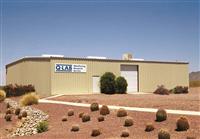
Q-Lab Arizona has a hot and dry desert climate year round.
-
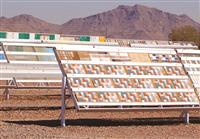
Samples shown here are backed with plywood and at a 45 degree orientation, for maximum exposure without tracking.
-
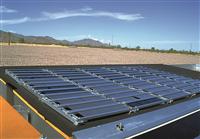
High temperatures are a major factor in Arizona exposure tests. Using a backing
increases the temperature of the specimens even more.
-
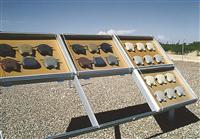
Sub-frames with window glass protect interior materials tested in "under glass" exposures.
-
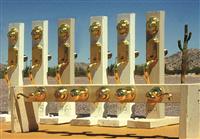
Doorknobs and locks under durability testing in Arizona's desert climate.
-
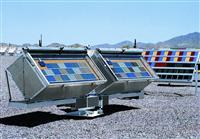
These AIM Boxes are used to test materials for automotive interiors. They can hold large, 3D parts like instrument panels.
-
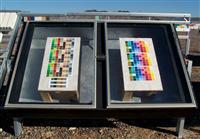
Ink specimens undergoing testing for fading and lightfastness behind window glass.
-
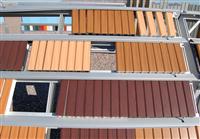
Exposure tests are performed on test panels and on actual parts. Test methods and the size, shape and material of specimens determine which type of direct exposure testing is right for your products.
-
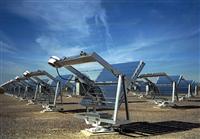
The Q-TRAC natural sunlight concentrator uses an array of 10 mirrors to reflect full-spectrum sunlight and concentrate it onto your test specimens.
-
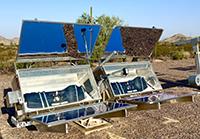
TRUE-AIM boxes feature dual-axis solar tracking, and a set of reflecting mirrors for enhanced solar exposure.